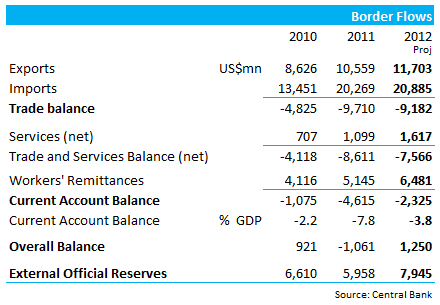In addition to exports, which were slightly down up to March 2012 compared to a year earlier, strong capital inflows are projected.
Capital Flows
Foreign direct investments are expected to almost double to 2.0 billion US dollars. The government may borrow up to a billion US dollars from a sovereign bond of which only 500 million would be used to repay a maturing bond.
About 483 million US dollars have flowed into government rupee securities by May 02, and there is space for 400 million US dollars more, Central Bank Governor Nivard Cabraal said.
So far 172 million US dollars have flowed into equities and 500 million dollars are projected. Banks have so far raised 880 million US dollars in second tier capital including a 500 million dollar bond by state-run Bank of Ceylon.
The central bank expects 1.4 billion US dollars from bank foreign borrowings, topping an original forecast of a billion US dollars.
"These will result in a healthy surplus in the balance of payments," Central Bank Governor Nivard Cabraal told reporters last week.
The state which deficit spends, is usually a net borrower and a key driver of imports. In 2011, net inflows to the state were 2.2 billion US dollars.
BOP Surplus
The bank is projecting a 1.25 billion US dollar 'balance of payments' surplus for 2012. A so-called 'balance of payments surplus' roughly correspondents to an increase in the central bank's foreign reserve account.
In order to 'capture' such a saving a central bank has to deny other market participants the use of the money coming from inflows, by selling down its Treasury bill portfolio and mop up rupee reserves in the banking system, effectively inducing savings.
The country's interest rates have to be at a rate enough to sell down the T-bill portfolio. During the past two months, the Treasury bill stock has largely stayed stable at a little below 220 billion rupees, after spiking in April due to debt monetizing.
By May 02, foreign reserves were at 5.9 billion US dollars, the Central Bank said. The level had been broadly stable for around two months.
Last year the Central Bank bought Treasury bills and injected rupee reserves in to the system, resisting an increase in interest rates and a contraction in the monetary base, fuelling unsustainable credit and import demand.
The central bank expected year end foreign reserves to reach 7.9 billion US dollars from 5.9 billion at the end of last year, inclusive of receipts from the International Monetary Fund.
Transactions with the IMF, which do not affect rupee reserves in the domestic banking system, do not trigger demand, imports or inflation.
Accounting Treatment
Human economists usually lump together items such as state and private loans, foreign investments in the so-called 'capital' account of the balance of payments and exports, remittances and tourism receipts into the 'current' account.
In the absence of a free capital account or a net repayment of government debt, or a sell down of Central Bank's Treasuries portfolio which is possible when credit growth slows, both types of inflows can fuel imports and generate a deficit in the current account.
Any Central Bank profit transfers to the state can also fuel imports and reduce foreign reserve and the 'balance of payments' surplus.
But economists and others have conditioned the public and investors to watch items classified as the 'current account' with trepidation, especially imports.
Up to March 2012 exports were 2.6 billion US dollars, down from 2.72 billion US dollars a year earlier.

By year end the Central Bank expects exports to rise to 11.7 billion US dollars up from 10.5 billion last year, remittances to 6.5 billion US dollars from 5.1 billion and tourism receipts to 1.2 billion US dollars from 800 million dollars last year, totaling 19.4 billion US dollars.
The Central Bank says existing policy measures in the form of higher interest rates and credit ceilings to keep imports at 20.8 billion US dollars. This would narrow the current account deficit to 2.3 billion US dollars from 4.6 billion US dollars a year earlier.
"As a result of the interventions we have provided to the economy in the first quarter of the year we will see the current account moderating to 3.8 percent of GDP from fairly high 7.8 percent that occurred last year," Cabraal said.
"It is very clearly possible. If you see in 2010 our current account balance was 2.2 percent, so it is possible for us to reach (3.8 percent)."
Update II
http://forum.srilankaequity.com/t17911-corporate-actions-announced-on-11th-may-2012-updated#118502
 would enable you to enjoy an array of other services such as Member Rankings, User Groups, Own Posts & Profile, Exclusive Research, Live Chat Box etc..
would enable you to enjoy an array of other services such as Member Rankings, User Groups, Own Posts & Profile, Exclusive Research, Live Chat Box etc.. 
 Home
Home
















